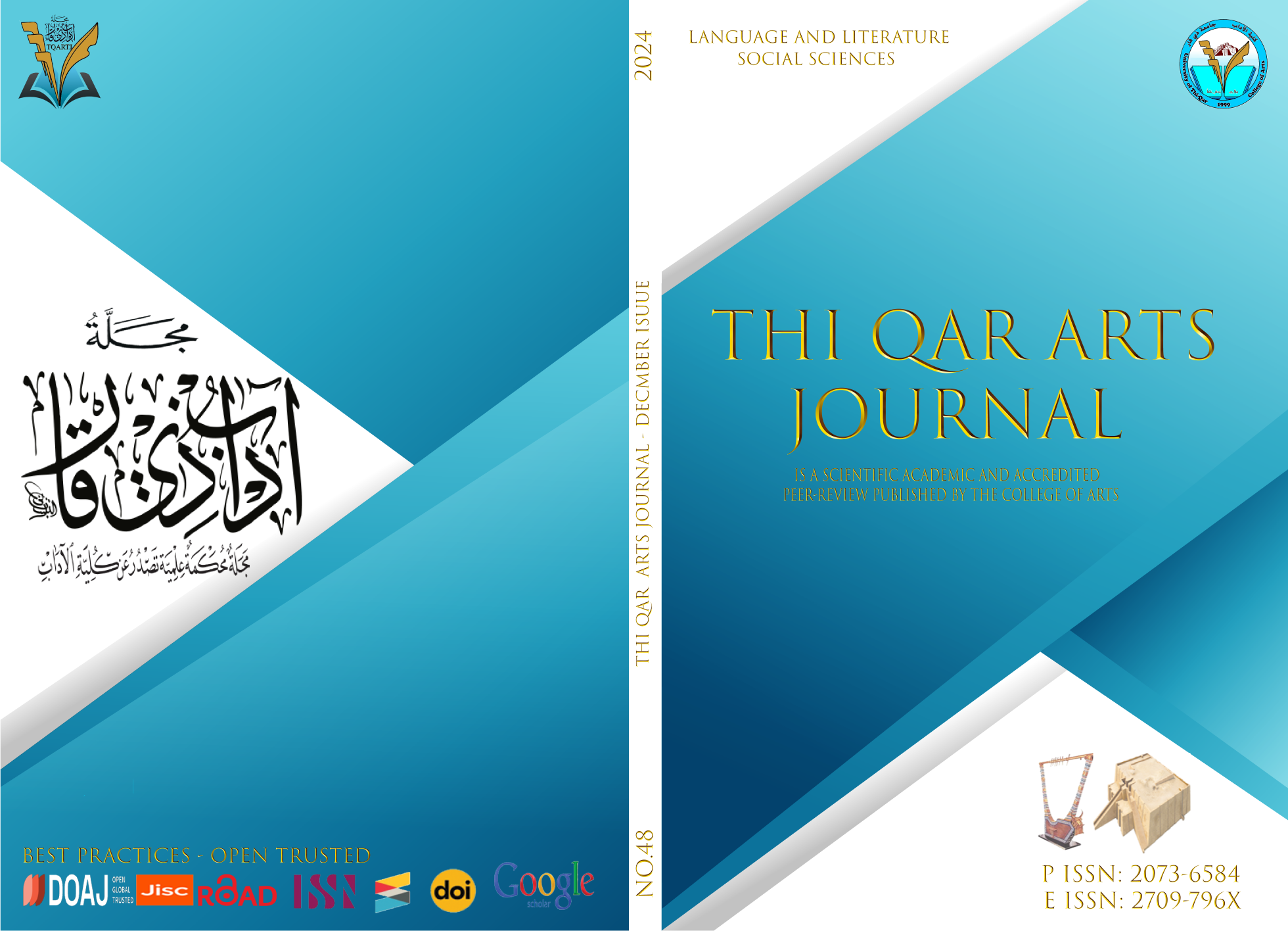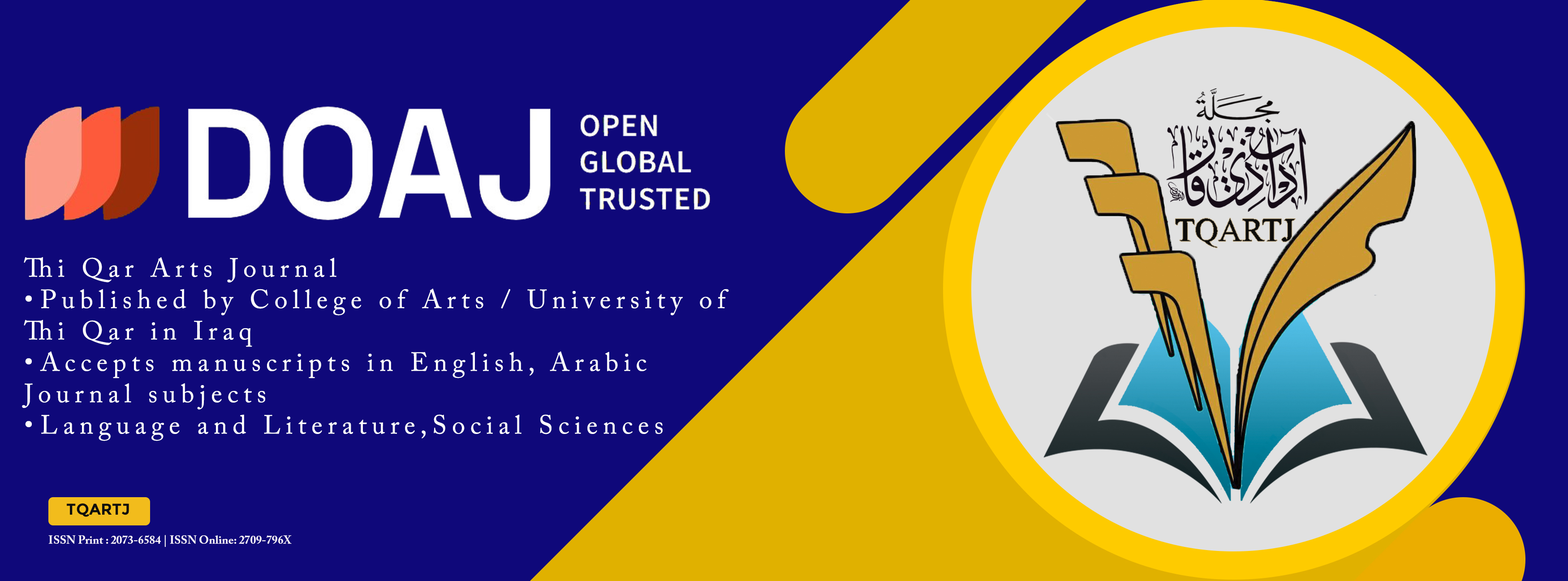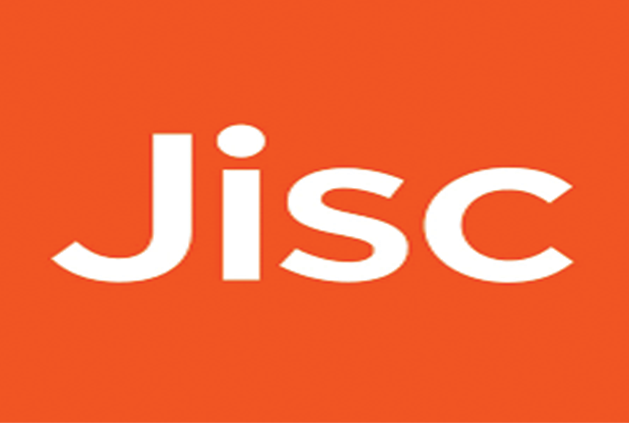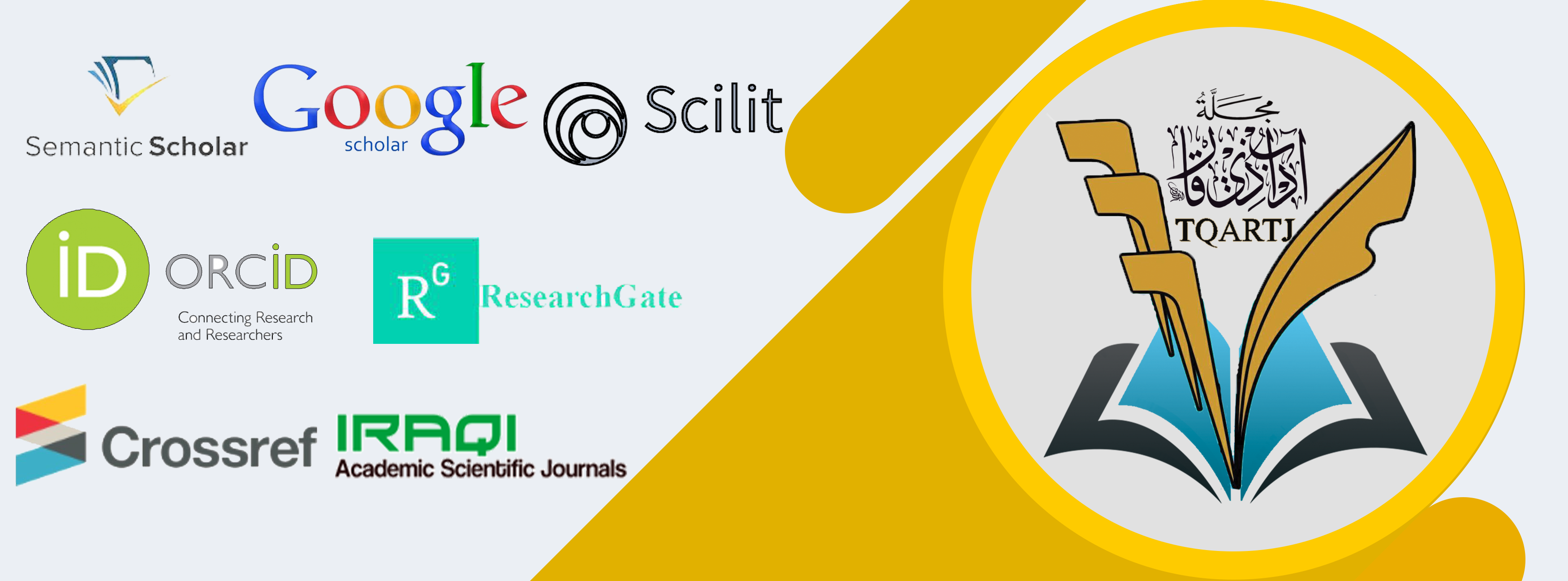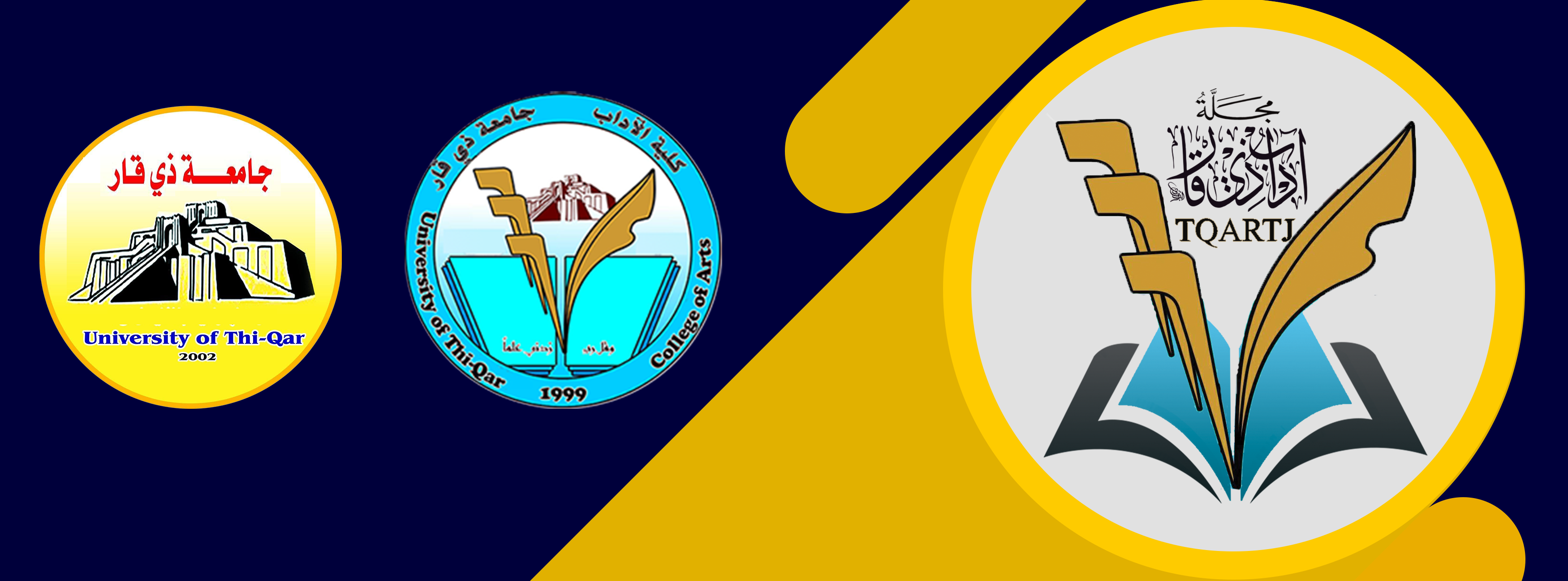Developing foreign language pragmatic competence in technology- enhanced classrooms and traditional classrooms: The case of Iraqi EFL learners
DOI:
https://doi.org/10.32792/tqartj.v11i48.652Keywords:
At University of IsfahanAbstract
According to Bardovi-Harlig and Mahan-Taylor (2003), pragmatic failure or differences in language learners’ production is often misinterpreted and taken on a personal level; not as a result of the process of language learning (this is in contrast to grammatical mistakes). This kind of differences or failure in the comprehension or production of pragmatic norms may result in ineffective communication (Alsuhaibani, 2020).Research on developing pragmatic competence has strongly indicated the efficiency of
pragmatics instruction to both L2 andforeign language learners
(Belz, 2007; Eun & Tadayoushi, 2006; Rose, 2005). Considering the point that teaching has the potential to develop the learners’ pragmatic competence, one important question which is raised is which approach can better facilitate developing pragmatic competence among L2 learners (Alsuhaibani, 2020). In each group, there will be 25 learners. The participants will be male and female subjects from different language proficiency levels (classified eventually to twogroups of low-proficiency and high-proficiency for easier data analyses). All the subjects of this study are native speakers of Arabic and will be taking courses for learning English whose emphasis is on improving communication skills. In addition to 10 EFL students, two EFL teachers will also be interviewed to answer the qualitative questions of the study. Some expert users of English in Iraq and Iran will be invited to help the researcher in conducting the research. These experts will communicate with the learners in the experimental groups over the treatment period. As for the examiners, one IELTS expert will be invited to help the researcher in marking and analyzing oral performances.
Downloads
References
Abolfathiasl, H., & Abdullah, A.N. (2015). Pragmatic consciousness-raising activities and EFL learners’ speech act performance of making suggestions. Journal of Language Teaching and Research, 6, 333–342.
Allami, H., & Naeimi, A. (2011). A cross-linguistic study of refusals: An analysis of pragmatic competence development in Iranian EFL learners. Journal of Pragmatics, 43(1), 385-406.
Alsuhaibani, Z. (2020). Developing EFL students’ pragmatic competence: The case of compliment responses. Language Teaching Research. doi: 10.1177/1362168820913539
Bachman, L., & Plamer, A. (1982). Language testing in practice: Design and developing useful language tests. Oxford: Oxford University Press.
Bardovi-Harlig, K. (2001) Evaluating the empirical evidence: Grounds for instruction in pragmatics? In Rose, K.R., & G. Kasper (Eds.), Pragmatics in language teaching (pp. 13–32). Cambridge: Cambridge University Press.
Bardovi-Harlig, K., & Dörnyei, Z. (1998). Do language learners recognize pragmatic violations? Pragmatic versus grammatical awareness in instructed L2 learning. TESOL Quarterly, 32, 232–262.
Bardovi-Harlig, K., & Hartford, B. (1991). Saying “No”: Native and nonnative rejections in English. In L. F. Bouton, & Y. Kachru (Eds.), Pragmatics and Language Learning, 40, 467-501.
Bardovi-Harlig, K., & Mahan-Taylor, R. (2003). Teaching pragmatics. Washington, DC: United States Department of State.
Belz, J. A. (2007). The role of computer mediation in the instruction and development of L2 pragmatic competence. Annual Review of Applied Linguistics, 27, 45-75.
Belz, J. A., & Kinginger, C. (2003). Discourse options and the development of pragmatic competence by classroom learners of German: The case of address forms. Language
Learning, 53(4), 591-647.
Belz, J., & Vyatkina, N. (2005). Learner corpus analysis and the development of L2 pragmatic competence in networked inter-cultural language study: The case of German modal particles. Canadian Modern Language Review, 62, 17–48.
Billmyer, K. (1990). I really like your life style: ESL learners learning how to compliment. Penn Working Papers in Educational Linguistics, 6, 31-48.
Blattner, G., & Fiori, M. (2009). Facebook in the language classroom: Promises and possibilities.
International Journal of Instructional Technology and Distance Learning, 6(1), 17-28.
Brown, L. (2010). Questions of appropriateness and authenticity in the representation of Korean honorifics in textbooks for second language learners. Language, Culture and Curriculum, 23(1), 35-50.
Canale, M., & Swain, M. (1980). Theoretical bases of communicative approaches to second language teaching and testing. Applied Linguistics, 1(1), 1-47.
Choo, M. (1999). Teaching language styles of Korean. In S. Kang (Ed.), The Korean language in America (pp. 77-95). Monterey, CA: American Association of Teachers of Korean.
Crystal, D. (1997). Cambridge encyclopedia of the English language (2nd ed.). Cambridge University Press.
Chun, D. (1994). Using computer networking to facilitate the acquisition of interactive competence. System, 22(1), 17-31.
Cunningham, D. J. (2016). Request modification in synchronous computer-mediated communication: The role of focused instruction. The Modern Language Journal, 100(2), 484-507.
Cunningham, D. J., & Vyatkina, N. (2012). Telecollaboration for professional purposes: Towards developing a formal register in the foreign language classroom. The Canadian Modern Language Review, 68, 422–450.
Eslami-Rasekh, Z., Islamic- Risked, A., & Fatahi, A. (2004). The effect of explicit metapragmatic instruction on the speech act awareness of advanced EFL students. TESL- EJ, 8(2), 1-12.
Eslami, Z. R. & Liu, C. N. (2013). Learning pragmatics through computer- mediated
communication in Taiwan. Iranian Journal of Society, Culture & Language, 1(1), 52-73.
Eslami, Z. R., Mirzaei, A., & Dini, S. (2014). The role of asynchronous computer mediated communication in the instruction and development of EFL learners' pragmatic competence. System, 48, 99-111.
Eun, J., & Tadayoushi, K. (2006). Effects of L2 instruction on interlanguage pragmatic development: A meta-analysis In Norris, J., & L. Ortega (Eds.), Synthesizing research on language learning and teaching (pp. 165–112). Amsterdam / Philadelphia, PA: John Benjamins.
Gilmore, A. (2004). A comparison of textbook and authentic interactions. ELT Journal, 58(4), 363-374.
Gonzalez, A. (2013). Development of politeness strategies in participatory online environments: A case study. In Taguchi, N. & Sykes, J. M. (Eds.), Technology in interlanguage pragmatics research and teaching (pp. 101-120). Philadelphia, PA: John Benjamins.
Gonzalez-Carriedo, R., & Esprıvalo Harrell, P. (2018). Teachers’ attitudes toward technology in a two-way dual-language program. Computers in the Schools, 35(2), 111–133.
González-Lloret, M. (2018). Pragmatics in technology-mediated contexts. In A. Herraiz- Martínez & A. Sánchez-Hernández (Eds.), Learning second language pragmatics beyond traditional contexts (pp. 15–46). Bern, Switzerland: Peter Lang.
González-Lloret, M. (2019). Technology and L2 pragmatics learning. Annual Review of Applied Linguistics, 39, 113–127.
Guiraud, N., Longin, D., Lorini, E., Pesty, S., & Rivière, J. (2011). The face of emotions: a logical formalization of expressive speech acts. In K. P. Tumer, L. Yolum, L. Sonenberg & P. Stone (Eds.), Proceedings of the 10th international conference on autonomous agents and multiagent systems-volume 3 (pp. 1031–1038). Richland, SC: International Foundation for Autonomous Agents and Multiagent Systems.
Haastrup, K. (1986). Pragmatic and strategic competence in the assessment of oral proficiency.
System, 14(1), 71-79.
Hew, K. F., & Brush, T. (2007). Integrating technology into K-12 teaching and learning: Current
knowledge gaps and recommendations for future research. Educational Technology Research and Development, 55(3), 223–252.
House, J. (1996). Developing pragmatic fluency in English as a foreign language: Routines and metapragmatic awareness. Studies in Second Language Acquisition, 18(2), 225-252.
Hymes, D. (1972). On communicative competence. In J. B. Pride & J. Holmes (Eds.),
Sociolinguistics (pp. 269–293). Harmondsworth, UK: Penguin.
Ishihara, N., & Cohen, A.D. (2014). Teaching and learning pragmatics: Where language and culture meet. New York: Routledge.
Jeon, E., & Kaya, T. (2006). Effects of L2 instruction on interlanguage pragmatic development: a meta-analysis. In J. Norris, & L. Ortega (Eds.), Synthesizing research on language learning and teaching (pp. 165e211). Philadelphia: John Benjamins Publishing Company.
Kakegawa, T. (2009). Development of the use of Japanese sentence final particles through email correspondence. In N. Taguchi (Ed.), Pragmatic competence (pp. 301–334). New York/Berlin: Mouton de Gruyter.
Kasper, G., & Rose, K.R. (2002). Pragmatic development in a second language. Oxford: Blackwell.
Khatib, M. & Safari, M. (2012). The effects of different instructional methods on the acquisition of English politeness strategies. Iranian Journal of Applied Linguistics (IJAL), 15(2), 1- 32.
Kim, E. Y. A., & Brown, L. (2014). Negotiating pragmatic competence in computer mediated communication: The case of Korean address terms. CALICO Journal, 31, 264–284.
Lama, D. (2006). Using ICT to support young learners who are non-native speakers of English.
IATEFL Young Learner Newsletter, 6, 26–27.
Lewis, G. (2004). The internet and young learners. Oxford: Oxford University Press. Leech, G. (1983). Principles of pragmatics. New York: Longman.
Li, S. (2012). The effects of input-based practice on pragmatic development of requests in L2 Chinese. Language Learning, 62, 403–438.
Limberg, H. (2016). Teaching how to apologize: EFL textbooks and pragmatic input. Language Teaching Research, 20, 700–718.
LoCastro, V. (1997). Pedagogical intervention and pragmatic competence development. Applied Language Learning, 8(1), 75-109.
Lyster, R. (1994). The effect of functional-analytic teaching on aspects of French immersion students’ sociolinguistic competence. Applied Linguistics, 15(3), 263-287.
Macaruso, P., & Rodman, A. (2011). Benefits of computer-assisted instruction to support reading acquisition in English language learners. Bilingual Research Journal, 34(3), 301–315.
Martínez-Flor, A.M., Fernández-Guerra, A.F., & Usó-Juan, E.U. (Eds.). (2003). Pragmatic competence and foreign language teaching. Castellón de la Plana: Publicacions de la Universitat Jaume.
Morady Moghaddam, M. (2019). Responses to compliments in online English chat: A comparison between Iranian EFL learners and native English speakers. Journal of Multicultural Discourses, 14(2), 167–187.
Morady Moghaddam, M., Murry, N., & Mirfendereski, Y. (2020). Pragmatic competence as a regulator of foreign language speaking proficiency. Porta Linguarum 33,163-182.
Morris, C. (1938). Foundations of the theory of signs. In O. Neuratin., R. Carnao., & C. W. Morris. (Eds.), International encyclopedia of unified science (Vol. 2, pp. 279-339). Chicago: University of Chicago Press.
Norrick, N. R. (1978). Expressive illocutionary acts. Journal of Pragmatics, 2(3), 277–291.
Olshtain, E., & Blum-Kulka, S. (1985). Crosscultural pragmatics and the testing of communicative competence. Language Testing, 2(1), 16-30.
Plonsky, L., & Zhuang, J. (2019). A meta-analysis of second language pragmatics instruction. In
N. Taguchi (Ed.), Routledge handbook of SLA and pragmatics (pp. 287–307). London, UK: Routledge.
Pojanapunya, P., & Jaroenkitboworn, K. (2011). How to say “Good-bye” in Second Life.
Journal of Pragmatics, 43, 3591–3602.
Ren, W., & Han, Z. (2016). The representation of pragmatic knowledge in recent ELT textbooks.
ELT Journal, 70, 424–434.
Rose, K.R. (2005). On the effects of instruction in second language pragmatics. System, 33, 385 399.
Ryan, J. (2016). Introducing referents for recognition: L2 pragmatic competence and miscommunication. Journal of Pragmatics, 97, 55-73.
Sarani, A., & Talati-Baghsiahi, A. (2017). Explicit instruction of pragmatic features: Its impact on EFL learners’ knowledge of hedging devices in academic writing. Issues in Language Teaching, 6(1), 29-53.
Schmidt, R. (1993). Consciousness, learning and interlanguage pragmatics. In Kasper, G., & S. Blum Kulba (Eds.), Interlanguage Pragmatics (pp. 21–42). Oxford: Oxford University Press.
Searle, J. R. (1976). A classification of illocutionary acts. Language in Society, 5, 1–23.
Sykes, J. M. (2005). Synchronous CMC and pragmatic development: Effects of oral and written chat. CALICO Journal, 22(3), 399-431.
Sykes, J. (2009). Learner request in Spanish: Examining the potential of multiuser virtual environments for L2 pragmatics acquisition. In L. Lomika & G. Lord (Eds.), The second generation: Online collaboration and social networking in CALL (pp. 199–234). San Marcos, TX: CALICO.
Sykes, J. M. (2013). Multiuser Virtual Environments: Learner apologies in Spanish. In Taguchi,
N. & Sykes, J. M. (Eds.), Technology in interlanguage pragmatics research and teaching
(pp. 71-100). Philadelphia, PA: John Benjamins.
Sykes, J. M. (2017). Technologies for teaching and learning intercultural competence and interlanguage pragmatics. In Chapelle, C. & Shannon, S. (Eds.), The handbook of technology and second language teaching and learning (pp. 119-133). Hoboken, NJ: John Wiley & Sons.
Sulaimani, A., Sarhandi, P., & Buledi, M. (2017). Impact of CALL in-house professional development training on teachers’ pedagogy: An evaluative study. Cogent Education, 4(1), 1–12.
Sullivan, N., & Pratt, E. (1996). A comparative study of two ESL writing environment: A computer-assisted classroom and a traditional oral classroom. System, 24(4), 491-501.
Sydorenko, T. (2015). The use of computer-delivered structured tasks in pragmatic instruction:
An exploratory study. Intercultural Pragmatics, 12(3), 333–362.
Taguchi, N. (Ed.). (2009). Pragmatic competence: Volume 5. Germany: Walter de Gruyter. Taguchi, N. (2011). Teaching pragmatics: Trends and issues. Annual Review of Applied
Linguistics, 31, 289-310.
Taguchi, N. (2015). Instructed pragmatics at a glance: Where instructional studies were, are, and should be going. Language Teaching, 48, 1–50.
Taguchi, N., & Roever, C. (2017). Second language pragmatics. Oxford, England: Oxford University Press.
Taguchi, N., & Sykes, J. M. (Eds.). (2013). Technology in interlanguage pragmatics research and teaching. Philadelphia, PA: John Benjamins.
Tajeddin, Z., & Hosseinpur, R. (2014). The impact of deductive, inductive, and L1-based consciousness-raising tasks on EFL learners' acquisition of the request speech act. Journal of Teaching Language Skills (JTLS), 6(1), 73-92.
Takamiya, Y., & Ishihara, N. (2013). Blogging: Crosscultural interaction for pragmatic development. In N. Taguchi & J. M. Sykes (Eds.), Technology in interlanguage pragmatics research and teaching (pp. 185–214). Amsterdam, the Netherlands: John Benjamins.
Tang, X. (2019). Use of technology for learning second language pragmatics. Applied Language Learning, 29(1&2), 52-72.
Thomas, J. (1983). Cross-cultural pragmatic failure. Applied Linguistics, 4, 91–112.
Thorne, S. L. (2006). Pedagogical and praxiological lessons from Internet-mediated intercultural foreign language education research. In J. A. Belz & S. L. Thorne (Eds.), Internet- mediated intercultural foreign language education (pp. 2–30). Boston: Thompson– Heinle.
van der Zwaard, R., & Bannink, A. (2014). Video call or chat? Negotiation of meaning and issues of face in telecollaboration. System, 44(1), 137e148.
Wang, H. S. (1999). Speech acts in Korean language textbooks: Representations and authenticity. Journal of Korean Language Education, 10(1), 195-220.
Webb, E., Jones, A., Barker, P., & van Schaik, P. (2007). Using e-learning dialogues in higher
education. Innovations in Education and Teaching International, 41(1), 93-103.
Widdowson, H.G. (1989). Knowledge of language and ability for use. Applied Linguistics, 10(2), 128–137.
Wishnoff, J. (2000). Hedging your bets: L2 learners’ acquisition of pragmatic devices in academic writing and computer-mediated discourse. Second Language Studies: Working Papers of the Department of Second Language Studies, University of Hawai‘i, 19, 119– 157.
Xu, J. (2010). On the problems and strategies of multimedia technology in English teaching.
Journal of Language Teaching and Research, 1(3), 215–218.
You, S. H. (2002). Teaching Korean kinship terms to foreign learners of Korean language: Addressing and referencing. In J. J. Ree (Ed.), The Korean language in America Vol. 7 (pp. 307-330). Monterey, CA: American Association of Teachers of Korean.
Yule, G. (1996). Pragmatics. Oxford: Oxford University Press.
Published
Issue
Section
Categories
License
Copyright (c) 2024 Athmar Alhool, Dr.Azizollah Dabaghi, Saeed Ketabi

This work is licensed under a Creative Commons Attribution 4.0 International License.
The journal applies the license of CC BY (a Creative Commons Attribution International license). This license allows authors to keep ownership of the copyright of their papers. But this license permits any user to download, print out, extract, reuse, archive, and distribute the article, so long as appropriate credit is given to the authors and the source of the work. The license ensures that the article will be available as widely as possible and that the article can be included in any scientific archive.
